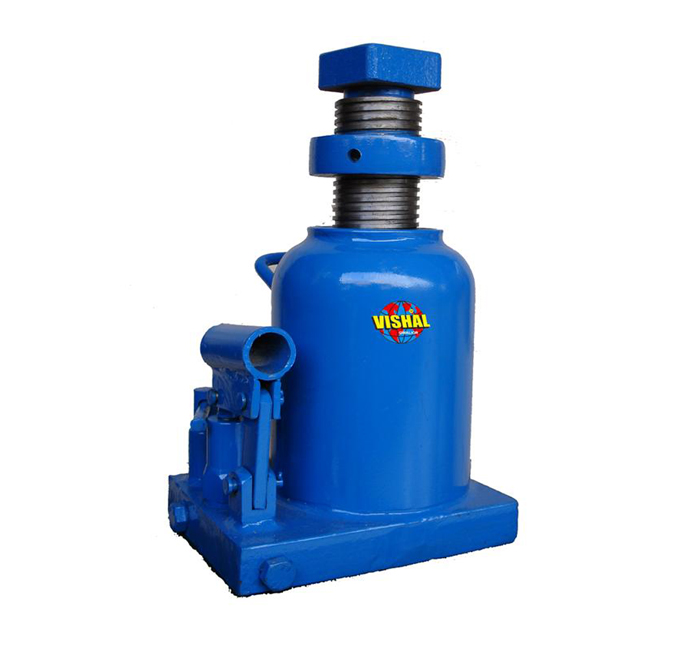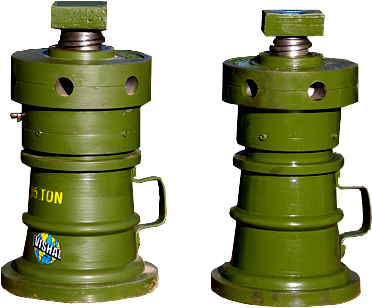Jack is one of the crucial part for lifting purpose, also used as basic vehicle-maintenance package in automobile. Automobile jacks come in two main varieties – mechanical screw jack and hydraulic bottle jack. A mechanical screw jack is the most common type and uses a mechanical screw mechanism to lift the car. A hydraulic bottle jack is more powerful but less compact and uses hydraulic fluid to lift the automobile.
A mechanical jack is a device which lifts heavy equipment using low human efforts in the most effective way. This is the most common form of jack which lifts vehicles so that maintenance can be performed.
Mechanical Jacks usually use mechanical advantage to allow a human to lift a vehicle by manual force alone. When the upper cap / nut is rotated anti-clockwise the screw (threaded RAM) starts lifting upwards moving the object to certain height and its clockwise function brings the object down to its actual position. Mechanical Jack is also used as a supporting jack with hydraulic jack. For the longer life of mechanical jack a hole is provided in the nut / cap which is used to provide grease to the bearing fitted in the nut / cap so that the jack.
Few years ago, Hydraulic jacks were typically used for shop work only, rather than as an emergency jack to be carried with the vehicle. Use of hydraulic jacks was not designed for a specific vehicle and use to require more than the usual maintenance/care. But now, during the recent developments in hydraulic systems, new and improved jacks have been developed to overcome all the lacking of the hydraulic jacks, viz. leakage of oil when kept in horizontal position instead of vertical upright position. A hydraulic jack uses a fluid, which is incompressible, that is forced into a cylinder by a pump plunger. Oil is used since it is self lubricating and stable. When the plunger pulls back, it draws oil out of the reservoir through a suction check valve into the pump chamber. When the plunger moves forward, it pushes the oil through a discharge check valve into the cylinder. The suction valve ball is within the chamber and opens with each draw of the plunger. The discharge valve ball is outside the chamber and opens when the oil is pushed into the cylinder. At this point the suction ball within the chamber is forced shut and oil pressure builds in the cylinder.
In a Hydraulic Bottle Jack the piston is vertical and directly supports a bearing pad that contacts the object being lifted. With a single action piston the lift is somewhat less than twice the collapsed height of the jack, making it suitable only for vehicles with a relatively high clearance: Source - Wikipedia.
In Hydraulic screw jack, the whole procedure is same as normal hydraulic bottle jack, but an additional feature i.e. THREADED RAM with THREADED RING (also called as safety ring) is used as an add-on from the safety point of view, where in when the RAM is lifted upto its maximum extended position, the ring is moved down so that, even accidently if the safety valve pops off, hydraulic jack won’t come down at all, giving additional ease to continue performing the maintenance work without any hassle.
Since the function of Jack is to offer stability to vehicle, quality and design is of most primary importance. Vishal Franko just understands this importance and for years has been supplying the world with jacks that just stand apart in terms of quality and performance
Visit: Mechanical Screw Jack, for more information on where to use which capacity of jack. Its range of jack serves 5 ton to 75 ton capacity (calculated on center load basis). You can go through the chart of its various models and choose your own suitable model.
| Capacity (Ton) | Suggested Vehicle (wheels) |
20 Ton |
4 wheel (mini bus/trucks, matador, tractor trolley, etc.) |
45 to 50 Ton |
6 wheel (Trucks, school bus, etc.) |
65 to 70 Ton |
10 to 16 wheels (Trailers, etc.) |
Visit: Hydraulic (Screw) Jack, for more information on where to use which capacity of jack. Its range of jack serves 60 ton & 80 ton capacity (calculated on center load basis) only. You can go through the chart of its various models and choose your own suitable model.
| Capacity (Ton) | Suggested Vehicle (wheels) |
65 to 70 Ton |
10 to 16 wheels (Trailers, etc.) |

Hydraulic Jack (Hydrolic Jack)


